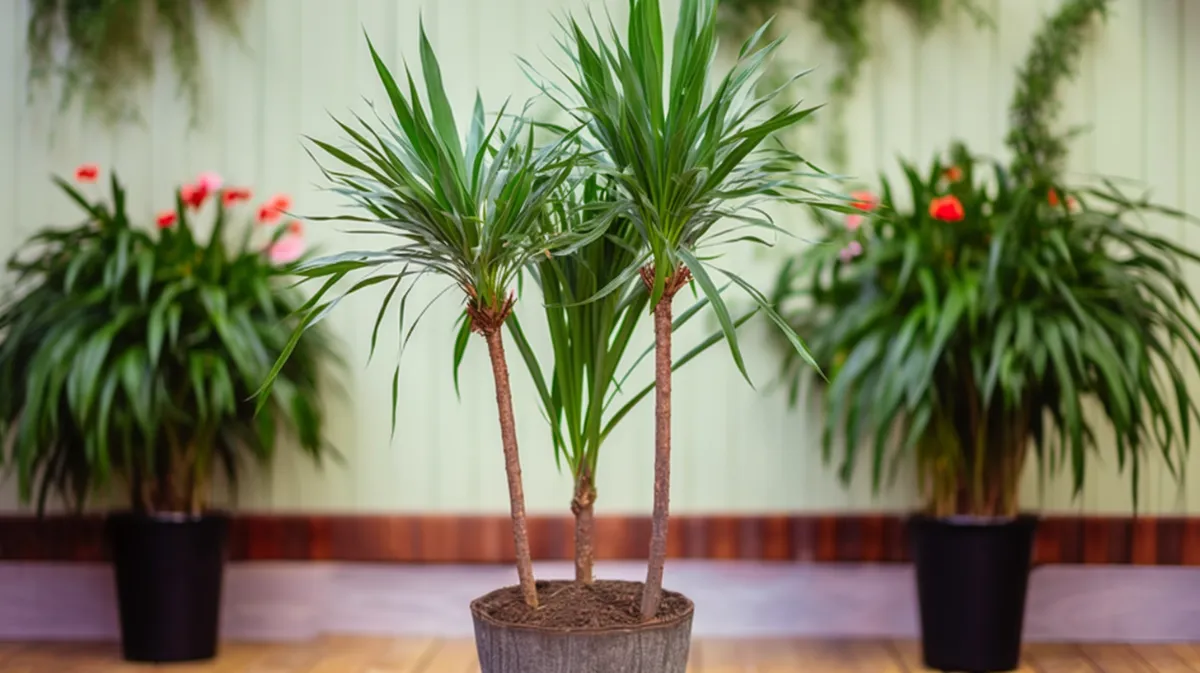
Imagine a garden filled with unique and exotic plants that are stunning and resilient. Picture succulents that combine the beauty of trees with their majesty. Welcome to the world of tree succulent plants!
In this guide, we will delve into the thriving beauty of tree succulent plants and explore their unique benefits, popular types, care tips, propagation techniques, and incorporation into landscape designs. Whether you’re a seasoned gardener looking to add elegance to your outdoor space or a novice starting your green journey, these fascinating plants will captivate you.
But first, let’s understand the basics of tree succulent plants and how they differ from common succulents…
Understanding the Basics of Tree Succulent Plants
Differences Between Tree Succulents and Common Succulents
Tree succulents differ from common succulents in their growth habit and size. While common succulents tend to be compact, tree succulents have a tree-like structure and grow tall. Additionally, tree succulents have distinct water storage capabilities and leaf structures.
Origins and Natural Habitat of Tree Succulents
Tree succulents are naturally found in arid regions such as deserts. They are commonly native to Africa, Madagascar, and parts of Central and South America.
The Unique Benefits of Tree Succulent Plants
Enhancing Garden and Interior Design with Tree Succulents
Tree succulents add a unique aesthetic appeal to any garden or interior space. Their tall and sculptural forms create visually striking focal points. They can be used as standalone specimens or incorporated into mixed plantings to add height and architectural interest.
Why Tree Succulents are Ideal for Novice Gardeners
Tree succulents are known for their durability and low maintenance requirements. They can tolerate periods of neglect and water scarcity, making them forgiving plants. This makes them suitable for novice gardeners or those with busy schedules.
Eco-Friendly Nature of Tree Succulents
Tree succulents have low water needs, which makes them an eco-friendly choice for water conservation. They require less water compared to many other plant species. Additionally, tree succulents have the ability to capture and store carbon, contributing to greenhouse gas reduction.
Popular Types of Tree Succulent Plants
Must-Know Varieties of Tree Succulent Plants
Some popular varieties of tree succulents include the aloe tree, pachypodium from Madagascar, and the dracaena or dragon tree. Each variety offers unique features and characteristics that make them stand out.
Key Features of the Aloe Tree
The aloe tree is known for its healing gel properties and striking appearance. It has thick, fleshy leaves arranged in a rosette form and can grow tall with a tree-like trunk. The aloe tree also produces beautiful tubular flowers that attract pollinators.
Majestic Nature of the Pachypodium from Madagascar
The pachypodium from Madagascar is known for its unique shape and ornamental value. It features a thick, swollen base called a caudex, which stores water during dry periods. This succulent tree also produces stunning clusters of flowers.
Characteristics of the Dracaena or Dragon Tree
The dracaena, or dragon tree, is a resilient tree succulent with long, slender leaves that are often variegated. It can tolerate a wide range of growing conditions, making it adaptable for indoor and outdoor settings. The dracaena adds a touch of tropical flair to any space.
Caring for Your Tree Succulent Plant
Soil Composition and Drainage for Tree Succulents
To ensure proper growth, tree succulents thrive in well-draining soil that replicates their natural habitat. You can create a well-draining succulent soil mix by combining regular potting soil with perlite or coarse sand.
Watering Tips for Tree Succulent Plants
When watering tree succulents, it’s important to strike a balance. Overwatering can lead to root rot, so allow the soil to dry out between waterings. Water thoroughly but infrequently to provide deep hydration without saturating the roots.
Sunlight and Temperature Requirements for Tree Succulents
Tree succulents typically thrive in bright, indirect sunlight. They prefer warm temperatures ranging from 70 to 85 degrees Fahrenheit (21 to 29 degrees Celsius) during the day. Provide some shade or protection from intense afternoon sun, especially in hotter climates.
Pest and Disease Protection for Tree Succulents
Regularly inspect the leaves and stems of tree succulents for signs of pests. Common pests include mealybugs and scale insects. If an infestation occurs, use suitable organic pesticides or insecticidal soaps to control the pests. Avoid overwatering or exposing the plant to cold, wet conditions to prevent fungal diseases.
Propagation Techniques for Tree Succulent Plants
Propagation Methods: Seeds versus Cuttings
While both seeds and cuttings can be used for propagating tree succulents, cuttings are generally more reliable and faster. Seeds may take longer to germinate and establish. Cuttings can be rooted in well-draining soil or water and have a higher success rate.
Role of Rooting Hormones in Successful Propagation
Rooting hormones, such as powder or gel formulations, can aid in successful rooting and establishment of tree succulent cuttings. These hormones stimulate root growth and increase the chances of a cutting developing a strong root system. However, they are not always necessary for all tree succulent varieties.
Caring for Newly Propagated Tree Succulents
After propagating tree succulents, provide proper care to ensure their growth and health. Keep the newly rooted cuttings in a warm and bright location with indirect sunlight. Water sparingly but regularly, and gradually introduce them to longer periods of sunlight to acclimate them to their new environment.
Incorporating Tree Succulents in Landscape Design
Blending Tree Succulents with Other Plant Varieties
To blend tree succulents with other plant varieties, consider contrasting their structure and leaf colors with different types of plants. Pair the vertical form of a tree succulent with low-growing ground covers or trailing plants. This creates a visually appealing composition that adds depth and interest to the landscape.
Potting and Repotting Tips for Tree Succulents Indoors
When potting tree succulents indoors, use a well-draining potting mix specifically formulated for succulents. Ensure the pot has drainage holes to prevent waterlogging. If the tree succulent outgrows its pot, repot it into a slightly larger container with fresh soil. Avoid placing tree succulents near cold drafts or heating vents.
Maximizing Tree Succulents in Small Gardens
Even in small gardens, tree succulents can be utilized to create vertical interest and maximize space. Plant them strategically in containers or raised beds to add height without taking up too much ground area. Create layers and use vertical space for growing other plant varieties, such as ground covers or colorful flowering plants.
Maintaining Tree Succulent Plants
Seasonal Maintenance and Care Routines
Tree succulents require different care and maintenance during different seasons:
| Season | Care Recommendations |
|---|---|
| Spring and Summer | Increase watering frequency to promote growth. |
| Fall and Winter | Reduce watering as the plants enter their dormant period. |
| All Seasons | Monitor temperature fluctuations and protect tree succulents from extreme cold or heat. |
Recognizing and Treating Common Issues
Despite your best efforts, tree succulents can sometimes face common issues:
| Issue | Recognition | Treatment |
|---|---|---|
| Overwatering | Yellowing leaves or root rot | Reduce watering frequency and improve drainage |
| Underwatering | Shriveled or wilted leaves | Increase watering frequency gradually |
| Pest Infestations | Presence of specific pests | Identify the pest and use appropriate organic pest control methods |
| Fungal Diseases | Fungal infections like powdery mildew or black spot | Use fungicides or remove affected parts promptly |
Enhancing Growth with Nutrient-Rich Fertilizers
To enhance the growth of tree succulents, consider the following:
-
-
- Choose a balanced, slow-release fertilizer specifically formulated for succulents.
- Apply the fertilizer sparingly, following the product instructions to avoid overfeeding.
- Fertilize tree succulents during their active growing season for optimal results.
- Consider using organic or natural fertilizers to minimize chemical exposure.
-
Conclusion
The Long-Term Joy of Growing Tree Succulents
Growing tree succulents can bring long-term joy as they mature and become focal points in your garden or interior space. Their unique forms and resilience make them captivating plants to care for and observe as they thrive over time.
Encouraging Sustainable Gardening with Tree Succulents
Tree succulents encourage sustainable gardening practices by their ability to thrive with low water needs. Their adaptation to arid environments reduces the overall water consumption in your garden. By choosing tree succulents, you contribute to sustainable gardening practices and the conservation of water resources.
FAQs on Tree Succulent Plants
Do tree succulents grow faster than regular succulents?
While growth rates can vary among species, tree succulents generally grow more slowly than some common succulents. Their aim is to reach tree-like heights over time, so while initial growth might seem sluggish, they can eventually achieve substantial heights.
How tall can tree succulents grow?
Some tree succulents, like the Dracaena or Aloe tree, can grow several feet tall. Specific height varies based on species, care, and environmental factors, but many can achieve heights of 5-15 feet or more in optimal conditions.
Can tree succulents survive in low light conditions?
Tree succulents generally prefer bright, indirect light, but many can tolerate low light conditions. However, insufficient light may lead to leggy growth or reduced vigor.
How often should tree succulents be repotted?
Repotting depends on the growth rate and size of the succulent. Generally, once every 2-3 years is sufficient. Look for signs like overcrowded roots or the plant outgrowing its pot.
What’s the difference between tree succulents and cacti?
While both cacti and tree succulents are adapted to store water, they belong to different plant families. Not all cacti are tree-like, and not all tree succulents are cacti. They also have different growth habits and care needs.
Do tree succulents need special fertilizer?
Tree succulents can benefit from fertilization, but they don’t always require a specialized fertilizer. A balanced, water-soluble fertilizer diluted to half-strength can be applied during the growing season.
Can tree succulents thrive indoors?
Yes, many tree succulents can be grown indoors as long as they receive adequate light, preferably near a south or west-facing window. Ensure the pot has good drainage and avoid overwatering.
How do I know if I’m overwatering my tree succulent?
Signs of overwatering include yellowing leaves, soft or mushy stems, and rot at the base. It’s essential to let the soil dry out between waterings and ensure proper drainage.
Is it possible to prune a tree succulent?
Yes, tree succulents can be pruned to maintain shape or size, promote branching, or remove dead or damaged parts. Ensure you’re using sterilized pruning tools to prevent the spread of disease.

I’m the mind behind house-plants.info. I’m a seasoned publisher with a green thumb and a passion for bringing the joys of indoor gardening to everyone. With over a decade of experience in online publishing, I aim to inspire and guide all plant enthusiasts, whether you’re just beginning your journey or have been a plant parent for years.
